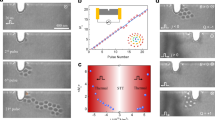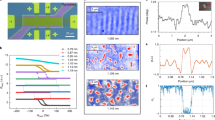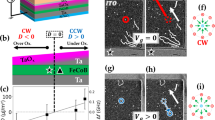Abstract
Topological whirls or ‘textures’ of spins such as magnetic skyrmions represent the smallest realizable emergent magnetic entities1,2,3,4,5. They hold considerable promise as robust, nanometre-scale, mobile bits for sustainable computing6,7,8. A longstanding roadblock to unleashing their potential is the absence of a device enabling deterministic electrical readout of individual spin textures9,10. Here we present the wafer-scale realization of a nanoscale chiral magnetic tunnel junction (MTJ) hosting a single, ambient skyrmion. Using a suite of electrical and multimodal imaging techniques, we show that the MTJ nucleates skyrmions of fixed polarity, whose large readout signal—20–70% relative to uniformly magnetized states—corresponds directly to skyrmion size. The MTJ exploits complementary nucleation mechanisms to stabilize distinctly sized skyrmions at zero field, thereby realizing three non-volatile electrical states. Crucially, it can electrically write and delete skyrmions to both uniform states with switching energies 1,000 times lower than the state of the art. Here, the applied voltage emulates a magnetic field and, in contrast to conventional MTJs, it reshapes both the energetics and kinetics of the switching transition, enabling deterministic bidirectional switching. Our stack platform enables large readout and efficient switching, and is compatible with lateral manipulation of skyrmionic bits, providing the much-anticipated backbone for all-electrical skyrmionic device architectures9,10. Its wafer-scale realizability provides a springboard to harness chiral spin textures for multibit memory and unconventional computing8,11.
This is a preview of subscription content, access via your institution
Access options
Access Nature and 54 other Nature Portfolio journals
Get Nature+, our best-value online-access subscription
$29.99 / 30 days
cancel any time
Subscribe to this journal
Receive 51 print issues and online access
$199.00 per year
only $3.90 per issue
Buy this article
- Purchase on Springer Link
- Instant access to full article PDF
Prices may be subject to local taxes which are calculated during checkout





Similar content being viewed by others
Data availability
Source data for the results presented in the paper and Supplementary Information are available at https://oar.a-star.edu.sg/communities-collections/articles/19631. Other relevant data are available from the corresponding author.
References
Nagaosa, N. & Tokura, Y. Topological properties and dynamics of magnetic skyrmions. Nat. Nanotechnol. 8, 899–911 (2013).
Romming, N. et al. Writing and deleting single magnetic skyrmions. Science 341, 636–639 (2013).
Moreau-Luchaire, C. et al. Additive interfacial chiral interaction in multilayers for stabilization of small individual skyrmions at room temperature. Nat. Nanotechnol. 11, 444–448 (2016).
Boulle, O. et al. Room-temperature chiral magnetic skyrmions in ultrathin magnetic nanostructures. Nat. Nanotechnol. 11, 449–454 (2016).
Soumyanarayanan, A. et al. Tunable room-temperature magnetic skyrmions in Ir/Fe/Co/Pt multilayers. Nat. Mater. 16, 898–904 (2017).
Jiang, W. et al. Blowing magnetic skyrmion bubbles. Science 349, 283–286 (2015).
Woo, S. et al. Observation of room-temperature magnetic skyrmions and their current-driven dynamics in ultrathin metallic ferromagnets. Nat. Mater. 15, 501–506 (2016).
Grollier, J. et al. Neuromorphic spintronics. Nat. Electron. 3, 360–370 (2020).
Fert, A., Reyren, N. & Cros, V. Magnetic skyrmions: advances in physics and potential applications. Nat. Rev. Mater. 2, 17031 (2017).
Back, C. et al. The 2020 skyrmionics roadmap. J. Phys. D. 53, 363001 (2020).
Dieny, B. et al. Opportunities and challenges for spintronics in the microelectronics industry. Nat. Electron. 3, 446–459 (2020).
Moodera, J. S., Kinder, L. R., Wong, T. M. & Meservey, R. Large magnetoresistance at room temperature in ferromagnetic thin film tunnel junctions. Phys. Rev. Lett. 74, 3273–3276 (1995).
Slonczewski, J. C. Current-driven excitation of magnetic multilayers. J. Magn. Magn. Mater. 159, L1–L7 (1996).
Parkin, S. S. P. et al. Giant tunnelling magnetoresistance at room temperature with MgO (100) tunnel barriers. Nat. Mater. 3, 862–867 (2004).
Yuasa, S., Nagahama, T., Fukushima, A., Suzuki, Y. & Ando, K. Giant room-temperature magnetoresistance in single-crystal Fe/MgO/Fe magnetic tunnel junctions. Nat. Mater. 3, 868–871 (2004).
Ikeda, S. et al. A perpendicular-anisotropy CoFeB-MgO magnetic tunnel junction. Nat. Mater. 9, 721–724 (2010).
Engel, B. N. et al. A 4-Mb toggle MRAM based on a novel bit and switching method. IEEE Trans. Magn. 41, 132–136 (2005).
Maccariello, D. et al. Electrical detection of single magnetic skyrmions in metallic multilayers at room temperature. Nat. Nanotechnol. 13, 233–237 (2018).
Zeissler, K. et al. Discrete Hall resistivity contribution from Néel skyrmions in multilayer nanodiscs. Nat. Nanotechnol. 13, 1161–1166 (2018).
Hsu, P.-J. et al. Electric-field-driven switching of individual magnetic skyrmions. Nat. Nanotechnol. 12, 123–126 (2017).
Li, S. et al. Experimental demonstration of skyrmionic magnetic tunnel junction at room temperature. Sci. Bull. 67, 691–699 (2022).
Guang, Y. et al. Electrical detection of magnetic skyrmions in a magnetic tunnel junction. Adv. Electron. Mater. 9, 2200570 (2023).
Kasai, S., Sugimoto, S., Nakatani, Y., Ishikawa, R. & Takahashi, Y. K. Voltage-controlled magnetic skyrmions in magnetic tunnel junctions. Appl. Phys. Expr. https://doi.org/10.7567/1882-0786/ab2baa (2019).
Penthorn, N. E., Hao, X., Wang, Z., Huai, Y. & Jiang, H. W. Experimental observation of single skyrmion signatures in a magnetic tunnel junction. Phys. Rev. Lett. 122, 257201 (2019).
Kim, D.-H., Park, K.-W. & Park, B.-G. Enhanced tunnel magnetoresistance and electric-field effect in CoFeB/MgO/CoFeB perpendicular tunnel junctions with W underlayer. Curr. Appl. Phys. 17, 962–965 (2017).
Chen, X. et al. Unveiling the emergent traits of chiral spin textures in magnetic multilayers. Adv. Sci. 9, 2103978 (2022).
Han, G. et al. Control of offset field and pinning stability in perpendicular magnetic tunnelling junctions with synthetic antiferromagnetic coupling multilayer. J. Appl. Phys. 117, 17B515 (2015).
Ho, P. et al. Geometrically tailored skyrmions at zero magnetic field in multilayered nanostructures. Phys. Rev. Appl. https://doi.org/10.1103/PhysRevApplied.11.024064 (2019).
Chen, H., Bouckaert, W. & Majetich, S. A. Tunnel magnetoresistance detection of skyrmions. J. Magn. Magn. Mater. 541, 168552 (2022).
Zhang, X. et al. Skyrmions in magnetic tunnel junctions. ACS Appl. Mater. Interfaces 10, 16887–16892 (2018).
Davies, J. E. et al. Magnetization reversal of Co/Pt multilayers: microscopic origin of high-field magnetic irreversibility. Phys. Rev. B 70, 224434 (2004).
Tan, A. K. C. et al. Skyrmion generation from irreversible fission of stripes in chiral multilayer films. Phys. Rev. Mater. https://doi.org/10.1103/PhysRevMaterials.4.114419 (2020).
Pomeroy, J. M., White, T. C., Grube, H., Read, J. C. & Davies, J. E. Magnetoresistance based first-order reversal curve analysis of magnetic tunnel junctions. Appl. Phys. Lett. https://doi.org/10.1063/1.3175723 (2009).
Büttner, F. et al. Field-free deterministic ultrafast creation of magnetic skyrmions by spin–orbit torques. Nat. Nanotechnol. 12, 1040–1044 (2017).
Cubukcu, M. et al. Ultra-fast perpendicular spin–orbit torque MRAM. IEEE Trans. Magn. 54, 9300204 (2018).
Wang, M. et al. Field-free switching of a perpendicular magnetic tunnel junction through the interplay of spin–orbit and spin-transfer torques. Nat. Electron. 1, 582–588 (2018).
Woo, S. et al. Deterministic creation and deletion of a single magnetic skyrmion observed by direct time-resolved X-ray microscopy. Nat. Electron. 1, 288–296 (2018).
Finizio, S. et al. Deterministic field-free skyrmion nucleation at a nanoengineered injector device. Nano Lett. 19, 7246–7255 (2019).
Bhattacharya, D. et al. Creation and annihilation of non-volatile fixed magnetic skyrmions using voltage control of magnetic anisotropy. Nat. Electron. 3, 539–545 (2020).
Niranjan, M. K., Duan, C.-G., Jaswal, S. S. & Tsymbal, E. Y. Electric field effect on magnetization at the Fe/MgO(001) interface. Appl. Phys. Lett. 96, 222504 (2010).
Wang, W.-G., Li, M., Hageman, S. & Chien, C. L. Electric-field-assisted switching in magnetic tunnel junctions. Nat. Mater. 11, 64–68 (2012).
Grezes, C. et al. Ultra-low switching energy and scaling in electric-field-controlled nanoscale magnetic tunnel junctions with high resistance-area product. Appl. Phys. Lett. 108, 012403 (2016).
Zhang, D. et al. Bipolar electric-field switching of perpendicular magnetic tunnel junctions through voltage-controlled exchange coupling. Nano Lett. 22, 622–629 (2022).
Jung, S. et al. A crossbar array of magnetoresistive memory devices for in-memory computing. Nature 601, 211–216 (2022).
Kateel, V. et al. Field-free spin–orbit torque driven switching of perpendicular magnetic tunnel junction through bending current. Nano Lett. 23, 5482–5489 (2023).
Lim, S. T., Tran, M., Chenchen, J. W., Ying, J. F. & Han, G. Effect of different seed layers with varying Co and Pt thicknesses on the magnetic properties of Co/Pt multilayers. J. Appl. Phys. 117, 17A731 (2015).
Chen, X. et al. Tailoring zero‐field magnetic skyrmions in chiral multilayers by a duet of interlayer exchange couplings. Adv. Funct. Mater. 33, 2304560 (2023).
Toh, A. K. J. et al. Stability and character of zero field skyrmionic states in hybrid magnetic multilayer nanodots. Preprint at https://arxiv.org/abs/2312.05801 (2023).
Zeissler, K. et al. Pinning and hysteresis in the field dependent diameter evolution of skyrmions in Pt/Co/Ir superlattice stacks. Sci. Rep. 7, 15125 (2017).
Tan, A. K. C. et al. Visualizing the strongly reshaped skyrmion Hall effect in multilayer wire devices. Nat. Commun. 12, 4252 (2021).
Emori, S., Bauer, U., Ahn, S. M., Martinez, E. & Beach, G. S. Current-driven dynamics of chiral ferromagnetic domain walls. Nat. Mater. 12, 611–616 (2013).
Legrand, W. et al. Room-temperature stabilization of antiferromagnetic skyrmions in synthetic antiferromagnets. Nat. Mater. 19, 34–42 (2020).
Li, X. et al. Enhancement of voltage-controlled magnetic anisotropy through precise control of Mg insertion thickness at CoFeB|MgO interface. Appl. Phys. Lett. 110, 052401 (2017).
Vansteenkiste, A. et al. The design and verification of MuMax3. AIP Adv. https://doi.org/10.1063/1.4899186 (2014).
Bisotti, M.-A. et al. Fidimag – a finite difference atomistic and micromagnetic simulation package. J. Open Res. Softw. https://doi.org/10.5334/jors.223 (2018).
Cortés-Ortuño, D. et al. Thermal stability and topological protection of skyrmions in nanotracks. Sci. Rep. 7, 4060 (2017).
Acknowledgements
We acknowledge helpful discussions with F. Ernult and B. Chen, and experimental inputs from J. Qiu, A. Kumar, P. Chauhan, Y.V. Bhobia, Z. Ma, Y. Niu and W.Y. Gan. This work was supported by the SpOT-LITE programme (grant no. A18A6b0057), funded by Singapore’s RIE2020 initiatives.
Author information
Authors and Affiliations
Contributions
J.L., P.H. and S.L.K.Y. designed the MTJ stack and wafer-level fabrication process, with inputs from H.J.C., S.T.L. and S.C. H.K.T., S.L.K.Y. and Y.T.T. performed the fabrication, aided by R.J.J.L., I.L. and N.C.B.L. S.C. performed the electrical and magnetometry measurements with help from R.J.J.L. and J.Z., and inputs from J.L. and X.C. A.K.J.T. and M.I.S. performed MFM, H.R.T. performed TEM, T.S.S. conducted BLS measurements, and J.H. supported their data analysis. J.H. performed simulations with inputs from X.C. S.C., J.L., P.H., and A.S. wrote the manuscript with inputs from all authors. A.S. coordinated and supervised the work.
Corresponding author
Ethics declarations
Competing interests
The authors declare no competing interests.
Peer review
Peer review information
Nature thanks Avik Ghosh and the other, anonymous, reviewer(s) for their contribution to the peer review of this work.
Additional information
Publisher’s note Springer Nature remains neutral with regard to jurisdictional claims in published maps and institutional affiliations.
Extended data figures and tables
Extended Data Fig. 1 Schematic of Multilayer Stacks.
Layer-wise structures of the three chiral multilayer stacks studied in this work: (a) full MTJ, (b) companion MTJ, and (c) composite free layer (FL). The SK-MTJ and P-MTJ compositions use different FM thicknesses within the FL (details in Methods).
Extended Data Fig. 2 Field Evolution of FL & SK-MTJ Films.
(a) OP M(H) loop of FL film and corresponding in-field LTEM images (arrow indicates sweep direction, field values indicated). (b) OP M(H) minor loops for SK-MTJ film and corresponding in-field LTEM images (saturated at −1.5 T). Top insets for (a-b) show colour bars indicating the field evolution of magnetic states: uniform magnetization (UM ↑,↓); skyrmion (SK ↑,↓), and labyrinthine stripes (LS).
Extended Data Fig. 3 Field Evolution of SK-MTJ and FL Dots.
MFM images of WDot ≃ 300 nm dot arrays (referenced to positively magnetized tip) for (a-b) SK-MTJ, after (a) −1.5 T saturation, and (b) +1.5 T saturation (flipped x-axis for ease-of-comparison), and (c) FL, respectively. Middle insets show colour bars indicating the field evolution of magnetic states: UM ↑,↓ and SK ↑,↓, respectively (c.f. Extended Data Fig. 2).
Extended Data Fig. 4 Estimation of VCMA Coefficient.
(a, c) Minor R(H) loops acquired on a WCell ≈ 300 nm SK-MTJ, with varying DC bias voltages, VDC of +1 V, 0 V, and −1 V (top to bottom) applied to the TE of the MTJ. (b, d) Variation with VDC of (b) perpendicular energy, E⊥ (represented by shaded regions in a). Red line indicates a linear fit, with extrapolated x-intercept ∼ +3.95 V.
Extended Data Fig. 5 Calculated VCMA Modulation of Skyrmion-to-Uniform Transition Energetics.
(a) GNEB-simulated magnetization images of the skyrmion (SK, left) to uniform state (UM, right) transition at ZF for a WDot = 300 nm FL dot (procedural details in Methods). (b) Energy profiles of the transition with VCMA modulation of the CoFeB (FL(i)) by \({\triangle K}_{{\rm{u}}}^{{\rm{CFB}}}\) = 0 (unchanged) and ±120 kJ/m3. The absolute total energy of the UM state was unchanged with ∆KuCFB (c,d). Evolution of (c) energy barrier, Eb and (d) energy difference, ∆E, with \({\triangle K}_{{\rm{u}}}^{{\rm{CFB}}}\) = 0 varied approximately over the voltage range used for electrical switching (VCMA estimation details in Methods). Coloured markers correspond to the curves in (b).
Extended Data Fig. 6 Bidirectional All-Electrical Switching of SK-MTJ.
(a) MR(H) loop of WCell ≃ 300 nm SK-MTJ (tCo ≃ 1.33 nm) used for switching measurements. (b) Bidirectional AP ↔ SK switching at constant H (−32 to −34 mT, green loops), with SK → AP switching (Vp < 0: left), followed by AP → SK switching (Vp > 0: right). Included for comparison: unidirectional AP → SK switching for varying H (−21 to −32 mT: blue curves). Dashed arrows indicate switching direction, solid asterisks represent MR of switched SK state for Vp ≃ +4.2 V. (c) MFM images at −20 mT, 0 mT, and +20 mT for major (top) and FORC (Hrev = +30 mT) loops (bottom). (d) Final MR of switched SK state (open-red, filled-orange asterisks from b) for varying H, compared to the major MR(H) loop (red, blue) and expected FORC minor loop (dashed orange line, see Fig. 4). Open-red and filled-orange squares indicate MFM-estimated MR for major and FORC (Hrev = +20 mT) loops, respectively.
Extended Data Fig. 7 Skyrmion Motion in FL Wires.
(a) In situ MFM image of 2 × 10 µm FL wire device (stack and fabrication details in Methods) at µ0H ≃ 74 mT. Highlighted box shows region of interest for c-e. (b) Schematic of experimental protocol: current pulses of alternating polarity, J ≃ ±(3.5 − 6.5) × 1011 A/m2, were applied sequentially, and the device was imaged before and after each pulse. (c) Top: representative zoom-in MFM images acquired before and after successive current pulses of opposite polarities (J ≃ 6.3 × 1011 A/m2). Small circles indicate positions of a few representative skyrmions across images; large, dashed circle identifies a prominent defect used for registration. Bottom: tracked positions of skyrmions across pulses (representative skyrmions highlighted), with arrows indicating extent of motion. (d) Polar plot of skyrmion motion statistics for µ0H ≃ 74 mT, compiled for selected J (data for J < 0 rotated by 180◦), showing a spread of velocities and deflections. (e) Plot of the average skyrmion velocity, ⟨vS⟩ against J. Error bars represent standard deviation.
Supplementary information
Supplementary Information
Supplementary sections 1–12, including Figs. 1–30, Tables 1–3 and References.
Rights and permissions
Springer Nature or its licensor (e.g. a society or other partner) holds exclusive rights to this article under a publishing agreement with the author(s) or other rightsholder(s); author self-archiving of the accepted manuscript version of this article is solely governed by the terms of such publishing agreement and applicable law.
About this article
Cite this article
Chen, S., Lourembam, J., Ho, P. et al. All-electrical skyrmionic magnetic tunnel junction. Nature 627, 522–527 (2024). https://doi.org/10.1038/s41586-024-07131-7
Received:
Accepted:
Published:
Issue Date:
DOI: https://doi.org/10.1038/s41586-024-07131-7
Comments
By submitting a comment you agree to abide by our Terms and Community Guidelines. If you find something abusive or that does not comply with our terms or guidelines please flag it as inappropriate.



